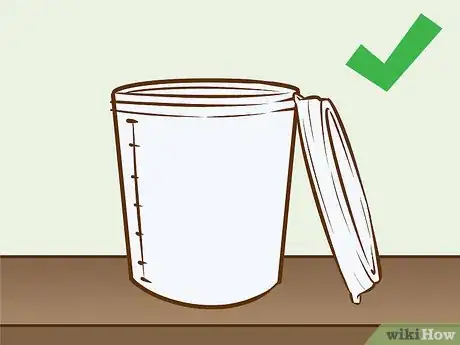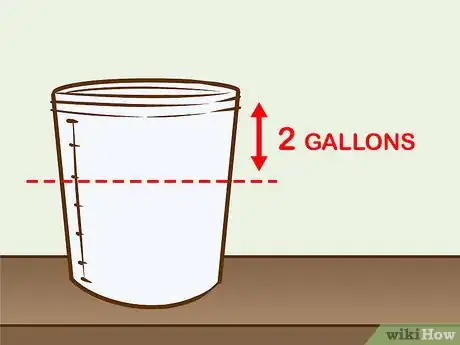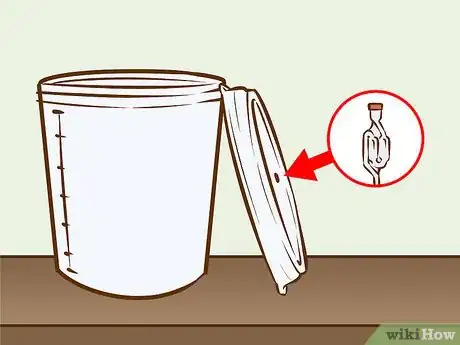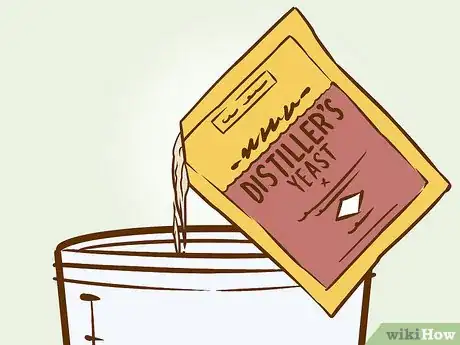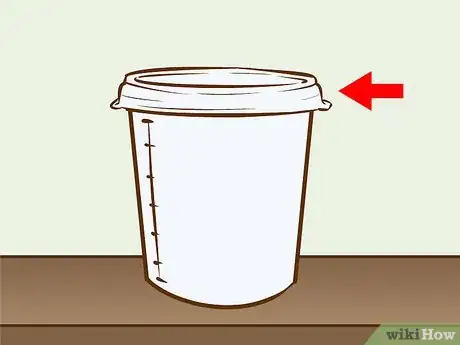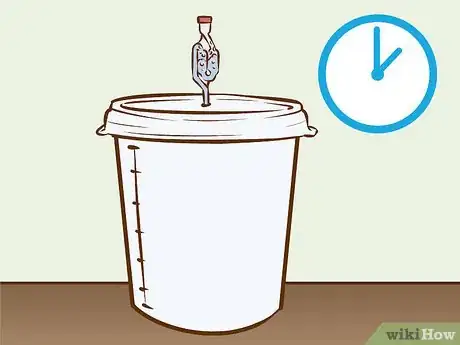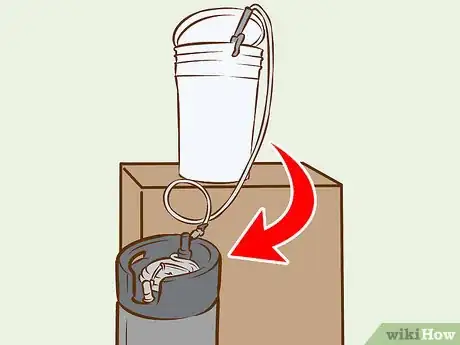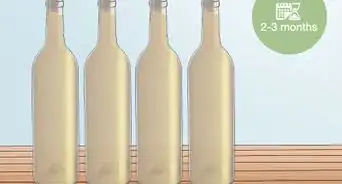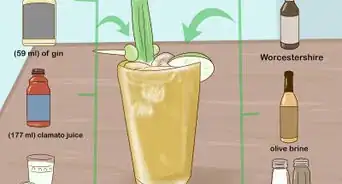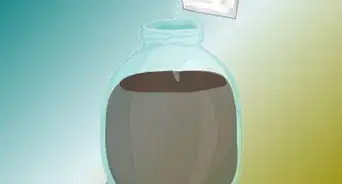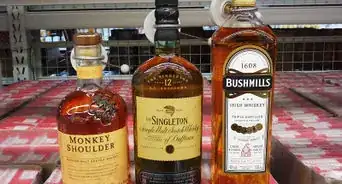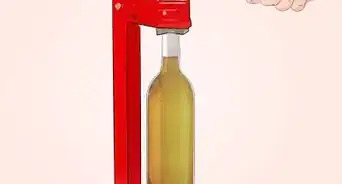This article was co-authored by Tom Blake. Tom Blake manages the bartending blog, craftybartending.com. He has been a bartender since 2012 and has written a book named The Bartender's Field Manual.
wikiHow marks an article as reader-approved once it receives enough positive feedback. This article received 19 testimonials and 91% of readers who voted found it helpful, earning it our reader-approved status.
This article has been viewed 1,815,707 times.
Many people are attracted to the idea of making their own alcoholic beverages. Luckily, it is straightforward and inexpensive to make alcohol from table sugar (sucrose). You need a fermentation vessel, sugar, and yeast for the fermentation process, and the ability to purify the alcohol you’ve made. Once you’ve produced the alcohol, you can use it to make liquors or mixed drinks.
Steps
Building a Vessel
-
1Use materials safe for consumption. You should only use food grade plastic buckets or glass carboys as your fermentation vessel. Make sure that the lid is food grade as well. A 7.5 gallon (28 L) vessel will allow for 5.5 to 6 gallon (21 to 23 L) batches. Keep in mind that you may occasionally need to stir the batch, so containers such as buckets are often ideal.[1]
-
2Leave extra room. You need about 1.5 to 2 gallons (5.7 to 7.6 L) worth of space in a 7.5 gallon (28 L) vessel. This allows room for the foam and gases that form during fermentation. If you don’t leave enough room, the pressure can build and pop the lid on the vessel, leading to contamination.[2]Advertisement
-
3Prepare the lid. You need to make a hole in the lid that is the right size for a rubber grommet and airlock. Push the grommet into the hole. Then fit the airlock into the top of the grommet. Install a rubber gasket around the lip of the lid to form an airtight seal between the lid and the container.[3]
-
4Clean and/or sanitize the equipment. The fermentation vessel (and rubber stopper for glass vessels or lid for a plastic bucket), airlock, and a large spoon should be cleaned and sanitized. Fill the fermentation vessel to the brim with a sanitizer, such as iodophor, that is made for brewing and winemaking. All these items are available at homebrewing and wine-making shops.[4]
Fermenting the Sugar
-
1Determine how much sugar (sucrose) to use. More sugar will result in more alcohol as long as the yeast can process it all. If you want a weaker batch (less alcohol) you can use less sugar. As a general guide, each packet of yeast will have directions that indicate how much sugar can be used.[5]
- If making two batches, be sure to use twice as much yeast (two packets).
-
2Dissolve the sugar. Mix the sugar into a pot of warm water to dissolve it. You can use tap water or bottled water. The water should be about 90 °F (32 °C). Use roughly 7 to 9 kilograms (15 to 20 lb) of sugar.[6]
- For a cleaner alcohol, use purified water.
-
3Pour the sugar solution into the vessel. When all of the sugar has been dissolved, carefully pour the sugar and water solution into the plastic bucket or glass carboy that you are using as a fermentation vessel. For a 7.5 gallon (28 L) vessel, pour 1.5 to 2 gallons (5.7 to 7.6 L) of solution. This sugar will be broken down by the yeast to produce alcohol.
- It is not necessary to sterilize the sucrose solution before fermenting, but if desired this can be done by boiling the sucrose solution for fifteen to twenty minutes. Take into account that some of the water will evaporate, so add a little more water before boiling.
-
4Add the yeast. Open the yeast packet and dump the yeast into the sugar water solution. If using a plastic bucket, stir to get an even mixture. Use a sanitized, dry funnel to help prevent a mess when adding the yeast to the narrow opening of a carboy.[7]
- Use one packet of yeast. More yeast can speed up the process, but it will not lead to a better yield of alcohol.
- Do not put the yeast into the sugar water until it has cooled. If the water is too hot it will kill the yeast.
-
5Wait one day. In the first days of fermentation, the yeast will expend most of its energy multiplying itself. Since this process requires oxygen, leave the lid off for the first 24 hours. If you cut off oxygen to the yeast immediately, the fermentation process will take much longer and may proceed sluggishly.[8]
-
6Affix the lid to the bucket. If using a plastic bucket, tightly push the lid onto the bucket so that an airtight seal is formed. This may be somewhat difficult and may require some leverage. An airtight seal is necessary for proper fermentation.[9]
- Fermentation is an anaerobic (lacking oxygen) process.
-
7Add water to the airlock. If you haven’t already, push the airlock into the lid if using a plastic bucket. If using a carboy, now is the time to push the airlock through a drilled rubber stopper and fit the stopper snugly in the mouth of the carboy. Add clean water or vodka to the inside of the airlock so that carbon dioxide can be released from the fermenting solution while air is kept out. The drop in available oxygen will cause the yeast to stop multiplying and start producing ethanol and carbon dioxide.[10]
-
8Let the mixture ferment. Keep the ambient temperature 70 to 80 °F (21 to 27 °C). This temperature will promote optimum performance from the yeast. It should take about two to ten days for the yeast to produce alcohol. The time required will vary depending on the type of yeast used, and on how much sugar was added. It will take longer to completely ferment more sucrose.[11]
-
9Stop the process. The airlock will bubble a lot during active fermentation. The bubbling will slow as fermentation slows, and stop completely when all or most of the sucrose has been fermented. If you are unsure, leave the batch for another day or two. Once the fermentation is over, it is time to purify the alcohol.
Purifying the Alcohol
-
1Clarify the fermented alcoholic liquid. After fermentation is complete, use a fining agent such as isinglass to remove suspended yeast and other material that may be present. Try to find isinglass that doesn't contain sulphites, as some people are allergic to sulphites. After adding the finings, reseal the fermenter with the lid or stopper and the airlock and allow the liquid to clarify for two or three days.[12]
- Use 0.5 to 1.0 gram of isinglass per 5 gallons (19 L) of batch.
-
2Siphon or pour off the alcoholic liquid. Siphon or carefully pour off the liquid into a glass carboy or other airtight container such as a cornelius keg. Leave the unwanted sediment behind in the fermentation vessel. You can also pour the liquid through a pad or membrane filter, such as a wine filter, to further clarify the liquid and remove residual yeast. Bottle the alcohol to preserve it.[13]
- Don't store the alcoholic liquid in a carboy for more than a month as it can become oxidized over time.
- Filter through a carbon filter if desired. Use a food-grade carbon filter to remove unwanted volatiles to further purify the alcohol. If flavors were added before this point, don't use the carbon filter because it will most likely strip out the flavors.
-
3Drink responsibly. Add your alcohol directly to jungle juice or add liqueur flavorings. You can also age the alcohol in sealed bottles to improve the flavor, especially if making liqueurs. New bottles can be found at home brewing shops.
- Reuse liquor bottles, wine bottles, and beer bottles, or use mason jars.
Expert Q&A
-
QuestionHow can I add flavor to alcohol?
 Tom BlakeTom Blake manages the bartending blog, craftybartending.com. He has been a bartender since 2012 and has written a book named The Bartender's Field Manual.
Tom BlakeTom Blake manages the bartending blog, craftybartending.com. He has been a bartender since 2012 and has written a book named The Bartender's Field Manual.
Professional Bartender Infuse the resulting mix with any ingredients you like. Add sugar to make it a liqueur. For instance, add strawberries and extra sugar to the mix and let it ‘steep’ for a few days, similar to how you would with tea.
Infuse the resulting mix with any ingredients you like. Add sugar to make it a liqueur. For instance, add strawberries and extra sugar to the mix and let it ‘steep’ for a few days, similar to how you would with tea. -
QuestionIs this legal? Would it be classified as moonshine?
 Anthony KolkaCommunity AnswerIt's legal if you don't sell it or distill it. it is illegal to distill alcohol without having either a "distilled spirits permit" or a "federal fuel alcohol permit" in the US.
Anthony KolkaCommunity AnswerIt's legal if you don't sell it or distill it. it is illegal to distill alcohol without having either a "distilled spirits permit" or a "federal fuel alcohol permit" in the US. -
QuestionDoes it give off a smell while making it?
 Community AnswerIt can give off a couple of smells. Sometimes, if the yeast isn't wine yeast and it's just regular bread yeast it can give off a rotten egg smell but that goes away when it's done fermenting.
Community AnswerIt can give off a couple of smells. Sometimes, if the yeast isn't wine yeast and it's just regular bread yeast it can give off a rotten egg smell but that goes away when it's done fermenting.
Warnings
- This crude type of alcohol will most likely taste awful if consumed without something else to mask the taste and if you drink too much it could give you a hangover you'll never forget.⧼thumbs_response⧽
- Only those of drinking age can legally make alcoholic beverages, and there are other laws regulating the production of alcohol, as well. Remember to drink responsibly.⧼thumbs_response⧽
References
- ↑ https://stillspirits.com/pages/fermenting-better-spirits
- ↑ https://stillspirits.com/pages/fermenting-better-spirits
- ↑ https://stillspirits.com/pages/fermenting-better-spirits
- ↑ https://stillspirits.com/pages/fermenting-better-spirits
- ↑ http://www.yobrew.co.uk/fermentation.php
- ↑ http://www.chemguide.co.uk/organicprops/alcohols/manufacture.html
- ↑ http://www.chemguide.co.uk/organicprops/alcohols/manufacture.html
- ↑ http://www.yobrew.co.uk/fermentation.php
- ↑ http://www.chemguide.co.uk/organicprops/alcohols/manufacture.html
About This Article
To make alcohol from common table sugar, you’ll need a carboy, an airlock, a pot, yeast, sugar, and water. Before you get started, sanitize all of your equipment so bacteria doesn’t ruin your batch. Then, measure out 1 ¼ cup (.25 kg) of granulated sugar for every 1 quart (1 liter) of water you want to use for your alcohol. The more water and sugar you use, the more alcohol you’ll make. Fill the pot with your desired amount of distilled water, then heat the water on a stovetop until it’s hot. Gradually add the sugar to the water, stirring continuously until it’s all dissolved. Next, take the sugar water off of the heat and let it cool to room temperature. Funnel the sugar water into the carboy. Now prepare the yeast by mixing it with warm water per the instructions on the packet. Use 1 packet of yeast for every 2 quarts (2 liters) of water you’re using. Funnel the activated yeast into the carboy and stir everything thoroughly. Secure the carboy with your airlock. The airlock will allow CO2 to escape from the carboy while preventing oxygen from getting in and disrupting the fermentation process. Finally, store the carboy in a dark, cool place for about 1-2 weeks. You’ll know the fermentation process is finished when you no longer see movement inside of the airlock, meaning no more CO2 is being emitted. If your alcohol is cloudy, you can add a clarifying agent to clear away the suspended yeast. Siphon or pour your alcohol into a sanitized glass container for storage, leaving behind any sediment. To learn how to purify your fermented alcohol, scroll down!
